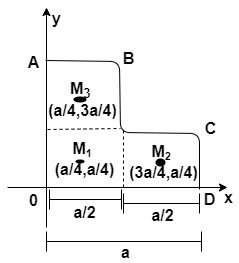Answer
384.3k+ views
Hint : Center of mass of a body or system of a particle is defined as, a point at which the whole of the mass of the body or all the masses of a system of particles appears to be concentrated.
Apply center of mass formula,
The equation can be applied individually to each axis,
$ \begin{align}
& {{X}_{com}}=\dfrac{\sum\limits_{i=0}^{n}{{{m}_{i}}{{x}_{i}}}}{M}=\dfrac{{{m}_{1}}{{x}_{1}}+{{m}_{2}}{{x}_{2}}+{{m}_{3}}{{x}_{3}}+...+{{m}_{n}}{{x}_{n}}}{M} \\
& {{Y}_{com}}=\dfrac{\sum\limits_{i=0}^{n}{{{m}_{i}}{{y}_{i}}}}{M}=\dfrac{{{m}_{1}}{{y}_{1}}+{{m}_{2}}{{y}_{2}}+{{m}_{3}}{{y}_{3}}+...+{{m}_{n}}{{y}_{n}}}{M} \\
\end{align} $
This formula is used for point objects.

Complete step by step solution:
We have given, a square whose side is a. divide the square into four equal parts.
If the upper part of the square is removed. Then we left with three parts of the square. Now, we have to find the coordinates of the centre of mass of the remaining three parts. Let M is the mass of particles at each corner of the square.
Use center of mass formula,
$ \begin{align}
& {{M}_{1}}\left( x,y \right)=\left( \dfrac{a}{4},\dfrac{a}{4} \right) \\
& {{M}_{2}}\left( x,y \right)=\left( \dfrac{3a}{4},\dfrac{a}{4} \right) \\
& {{M}_{3}}\left( x,y \right)=\left( \dfrac{a}{4},\dfrac{3a}{4} \right) \\
\end{align} $
Now, center of mass formula is given by,
$ \begin{align}
& {{X}_{com}}=\dfrac{{{M}_{1}}{{x}_{1}}+{{M}_{2}}{{x}_{2}}+{{M}_{3}}{{x}_{3}}}{M} \\
& {{M}_{1}}={{M}_{2}}={{M}_{3}}=M \\
& {{X}_{com}}=\dfrac{M\left( \dfrac{a}{4} \right)+M\left( \dfrac{3a}{4} \right)+M\left( \dfrac{a}{4} \right)}{M+M+M} \\
& {{X}_{com}}=\dfrac{\left( \dfrac{a}{4}+\dfrac{3a}{4}+\dfrac{a}{4} \right)M}{3M} \\
& {{X}_{com}}=\dfrac{5a}{4}\times \dfrac{1}{3}=\dfrac{5a}{12} \\
& {{Y}_{com}}=\dfrac{{{M}_{1}}{{y}_{1}}+{{M}_{2}}{{y}_{2}}+{{M}_{3}}{{y}_{3}}}{{{M}_{1}}+{{M}_{2}}+{{M}_{3}}} \\
& {{Y}_{com}}=\dfrac{M\left( \dfrac{a}{4} \right)+M\left( \dfrac{a}{4} \right)+M\left( \dfrac{3a}{4} \right)}{M+M+M} \\
& {{Y}_{com}}=\dfrac{\left( \dfrac{a}{4}+\dfrac{a}{4}+\dfrac{3a}{4} \right)M}{3M}=\dfrac{5a}{12} \\
\end{align} $
The coordinates of the centre of mass is $ \left( \dfrac{5a}{12},\dfrac{5a}{12} \right) $.
Note:
A point where the whole mass of the body can be assumed to be located or concentrated is called the centre of mass. The point can be real or imaginary, for example in case of a hollow or empty box the mass is physically not located at the centre of mass point. The mass is supposed to be located at the centre of mass in order to simplify calculations.
Apply center of mass formula,
The equation can be applied individually to each axis,
$ \begin{align}
& {{X}_{com}}=\dfrac{\sum\limits_{i=0}^{n}{{{m}_{i}}{{x}_{i}}}}{M}=\dfrac{{{m}_{1}}{{x}_{1}}+{{m}_{2}}{{x}_{2}}+{{m}_{3}}{{x}_{3}}+...+{{m}_{n}}{{x}_{n}}}{M} \\
& {{Y}_{com}}=\dfrac{\sum\limits_{i=0}^{n}{{{m}_{i}}{{y}_{i}}}}{M}=\dfrac{{{m}_{1}}{{y}_{1}}+{{m}_{2}}{{y}_{2}}+{{m}_{3}}{{y}_{3}}+...+{{m}_{n}}{{y}_{n}}}{M} \\
\end{align} $
This formula is used for point objects.

Complete step by step solution:
We have given, a square whose side is a. divide the square into four equal parts.
If the upper part of the square is removed. Then we left with three parts of the square. Now, we have to find the coordinates of the centre of mass of the remaining three parts. Let M is the mass of particles at each corner of the square.
Use center of mass formula,
$ \begin{align}
& {{M}_{1}}\left( x,y \right)=\left( \dfrac{a}{4},\dfrac{a}{4} \right) \\
& {{M}_{2}}\left( x,y \right)=\left( \dfrac{3a}{4},\dfrac{a}{4} \right) \\
& {{M}_{3}}\left( x,y \right)=\left( \dfrac{a}{4},\dfrac{3a}{4} \right) \\
\end{align} $
Now, center of mass formula is given by,
$ \begin{align}
& {{X}_{com}}=\dfrac{{{M}_{1}}{{x}_{1}}+{{M}_{2}}{{x}_{2}}+{{M}_{3}}{{x}_{3}}}{M} \\
& {{M}_{1}}={{M}_{2}}={{M}_{3}}=M \\
& {{X}_{com}}=\dfrac{M\left( \dfrac{a}{4} \right)+M\left( \dfrac{3a}{4} \right)+M\left( \dfrac{a}{4} \right)}{M+M+M} \\
& {{X}_{com}}=\dfrac{\left( \dfrac{a}{4}+\dfrac{3a}{4}+\dfrac{a}{4} \right)M}{3M} \\
& {{X}_{com}}=\dfrac{5a}{4}\times \dfrac{1}{3}=\dfrac{5a}{12} \\
& {{Y}_{com}}=\dfrac{{{M}_{1}}{{y}_{1}}+{{M}_{2}}{{y}_{2}}+{{M}_{3}}{{y}_{3}}}{{{M}_{1}}+{{M}_{2}}+{{M}_{3}}} \\
& {{Y}_{com}}=\dfrac{M\left( \dfrac{a}{4} \right)+M\left( \dfrac{a}{4} \right)+M\left( \dfrac{3a}{4} \right)}{M+M+M} \\
& {{Y}_{com}}=\dfrac{\left( \dfrac{a}{4}+\dfrac{a}{4}+\dfrac{3a}{4} \right)M}{3M}=\dfrac{5a}{12} \\
\end{align} $
The coordinates of the centre of mass is $ \left( \dfrac{5a}{12},\dfrac{5a}{12} \right) $.
Note:
A point where the whole mass of the body can be assumed to be located or concentrated is called the centre of mass. The point can be real or imaginary, for example in case of a hollow or empty box the mass is physically not located at the centre of mass point. The mass is supposed to be located at the centre of mass in order to simplify calculations.
Recently Updated Pages
How many sigma and pi bonds are present in HCequiv class 11 chemistry CBSE

Why Are Noble Gases NonReactive class 11 chemistry CBSE

Let X and Y be the sets of all positive divisors of class 11 maths CBSE

Let x and y be 2 real numbers which satisfy the equations class 11 maths CBSE

Let x 4log 2sqrt 9k 1 + 7 and y dfrac132log 2sqrt5 class 11 maths CBSE

Let x22ax+b20 and x22bx+a20 be two equations Then the class 11 maths CBSE

Trending doubts
Fill the blanks with the suitable prepositions 1 The class 9 english CBSE

At which age domestication of animals started A Neolithic class 11 social science CBSE

Which are the Top 10 Largest Countries of the World?

Give 10 examples for herbs , shrubs , climbers , creepers

Difference between Prokaryotic cell and Eukaryotic class 11 biology CBSE

Difference Between Plant Cell and Animal Cell

Write a letter to the principal requesting him to grant class 10 english CBSE

Change the following sentences into negative and interrogative class 10 english CBSE

Fill in the blanks A 1 lakh ten thousand B 1 million class 9 maths CBSE



